Mackinder’s Heartland and the (USDS) US Deep State’s Chess Game
Living in an fully interconnected world, it’s essential to understand the historic background of the term
Geopolitics
In a 1904 speech, titled, ‘The Geographical Pivot of History,’ a British geographer named Halford Mackinder sought to define Geopolitics as the relation between a nation’s geography (its topography) and its sea or land (its climate), with its politics and position in the world.
He posited two classes of powers: the sea powers Britain, USA, and Japan; the large land powers of Eurasia, which, with development of the railroad, were able to unite large land masses free from dependency on seaports.
For Mackinder, the implicit lesson for continued hegemony of the British Empire following the 1914-1917 World War, was to prevent at all costs a convergence of interests between the nations of East Europe and the Russia-centered Eurasia ‘Heartland’ or ‘pivot’ land, as he termed it. He summed up his ideas in the following famous dictum:
"Who rules East Europe commands the Heartland;
Who rules the Heartland commands the World-Island;
Who rules the World-Island commands the world."
The World-Island, comprises of the interlinked continents of Europe, Asia, and Africa (Afro-Eurasia). The Heartland lays at its center, stretching from the Volga to the Yangtze and from the Himalayas to the Arctic.
From a US perspective, the 1946-1991 Cold War era was all about who shall control Mackinder’s World-Island. It is the principal strategic aim of the USDS to keep Eurasia from unifying as a coherent economic and military bloc and counterweight to the sole superpower status of the USA, because, as Z. Brzezinski wrote in 2006:
“Eurasia is home to most of the world's politically assertive and dynamic states. The main world religions and all historical pretenders to global power originated in Eurasia. The world's most populous aspirants to regional hegemony, China and India, are in Eurasia, as are all the potential political or economic challengers to American primacy. After the United States, the next six largest economies and military spenders are there, as are all but one of the world's overt nuclear powers, and all but one of the covert ones. Eurasia accounts for 75% of the world's population, 60% of its GNP, and 75% of its energy resources. Collectively, Eurasia's potential power overshadows even America's.
Eurasia is the world's axial super-continent. A power that dominated Eurasia would exercise decisive influence over two of the world's three most economically productive regions, Europe and East Asia. A glance at the map also suggests that a country dominant in Eurasia would almost automatically control the Middle East and Africa. With Eurasia now serving as the decisive geopolitical chessboard, it no longer suffices to fashion one policy for Europe and another for Asia. What happens with the distribution of power on the Eurasian landmass will be of decisive importance to America's global primacy”.
If we take the words of USDS strategist Brzezinski and understand the axioms of Mackinder as the driving motive for Anglo, and later, American foreign policy for more than an entire century, it begins to become clear why a re-organized Russian state has gone into motion to resist the overt attempts at deconstruction by the USDS in the name of democracy. How has Russia acted to shore up its defenses? In one word:
Energy (Chi)
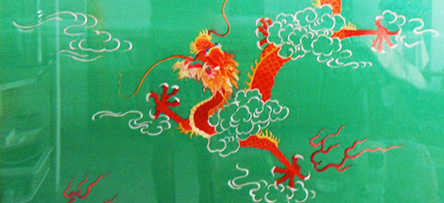
Russian Energy Geopolitics
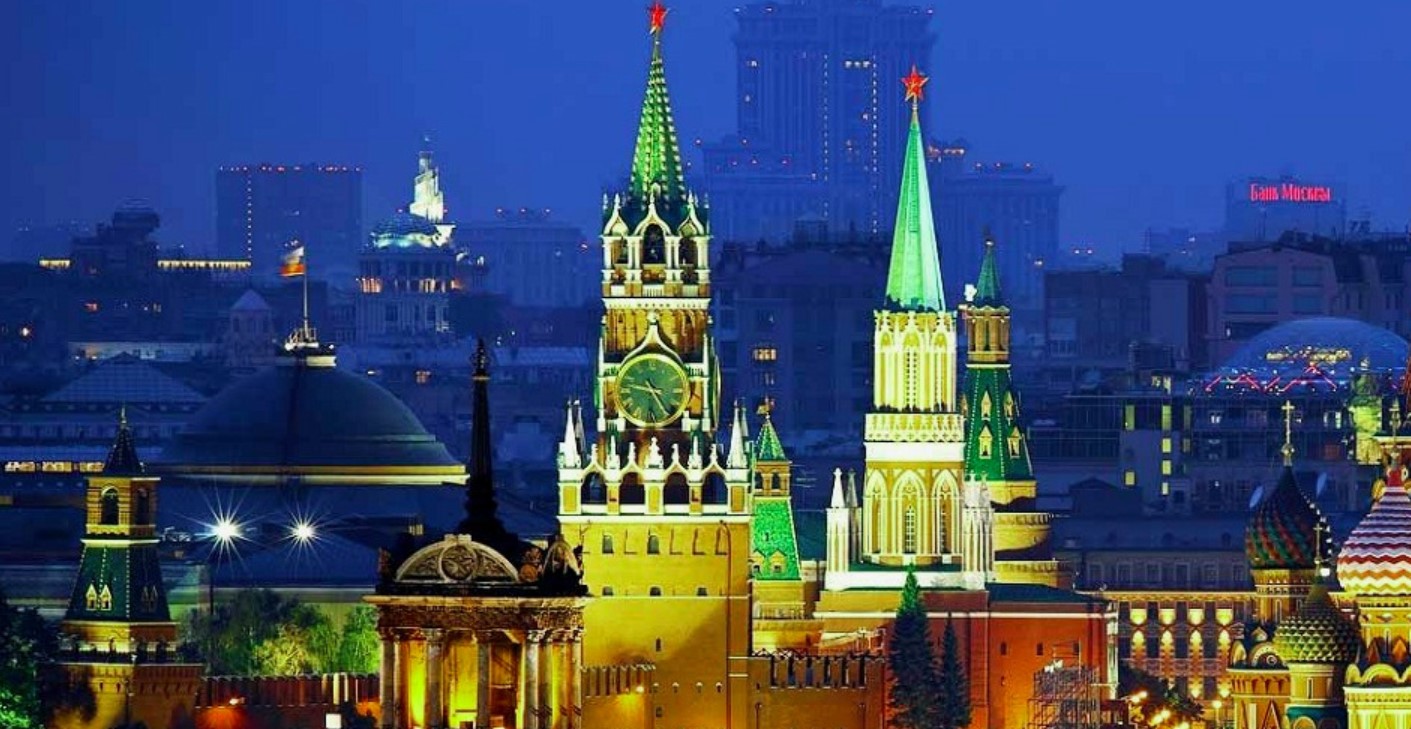
In terms of the overall secular and spiritual standard of living, Russia, a very ancient vedic land, is steadily becoming a world class power again, after its collapse in mid 1991. In terms of energy, it is a colossus. In terms of landmass it is still the single largest nation in land area in the world, spanning from the Pacific to the door of Europe.
Russia's Cyrillic script is a writing system used for various alphabets across Eurasia and is used as the national script in various Slavic-, Turkic- and Persian-speaking countries in Eastern Europe, the Caucasus, Central Asia, and North Asia. It has its origins in the ancient Vedic Sanskrit language.
It has vast territory, vast natural resources, and it has the world’s largest reserves of natural gas, the energy source currently the focus of major global power plays. In addition, it is the only power with the military capabilities able to match that of the USDS despite the collapse of the USSR and its military force.
Oil drilling began in 1865 in Krasnodar Krai. By 2006 Russia had more than 130,000 oil wells and some 2000 oil and gas deposits explored of which about half are not in use.
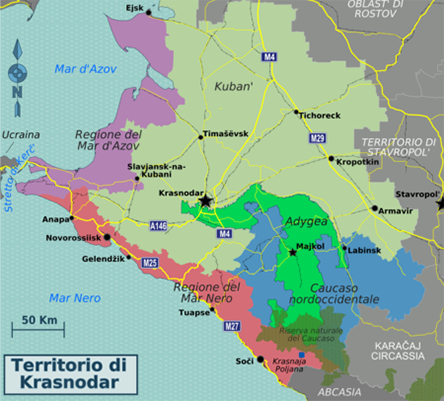
Oil reserves have been estimated at about the same as Iraq. Since Arctic drilling has started, this will be much more. The known mineral stock in the permafrost is worth over 30 Trillion dollars:
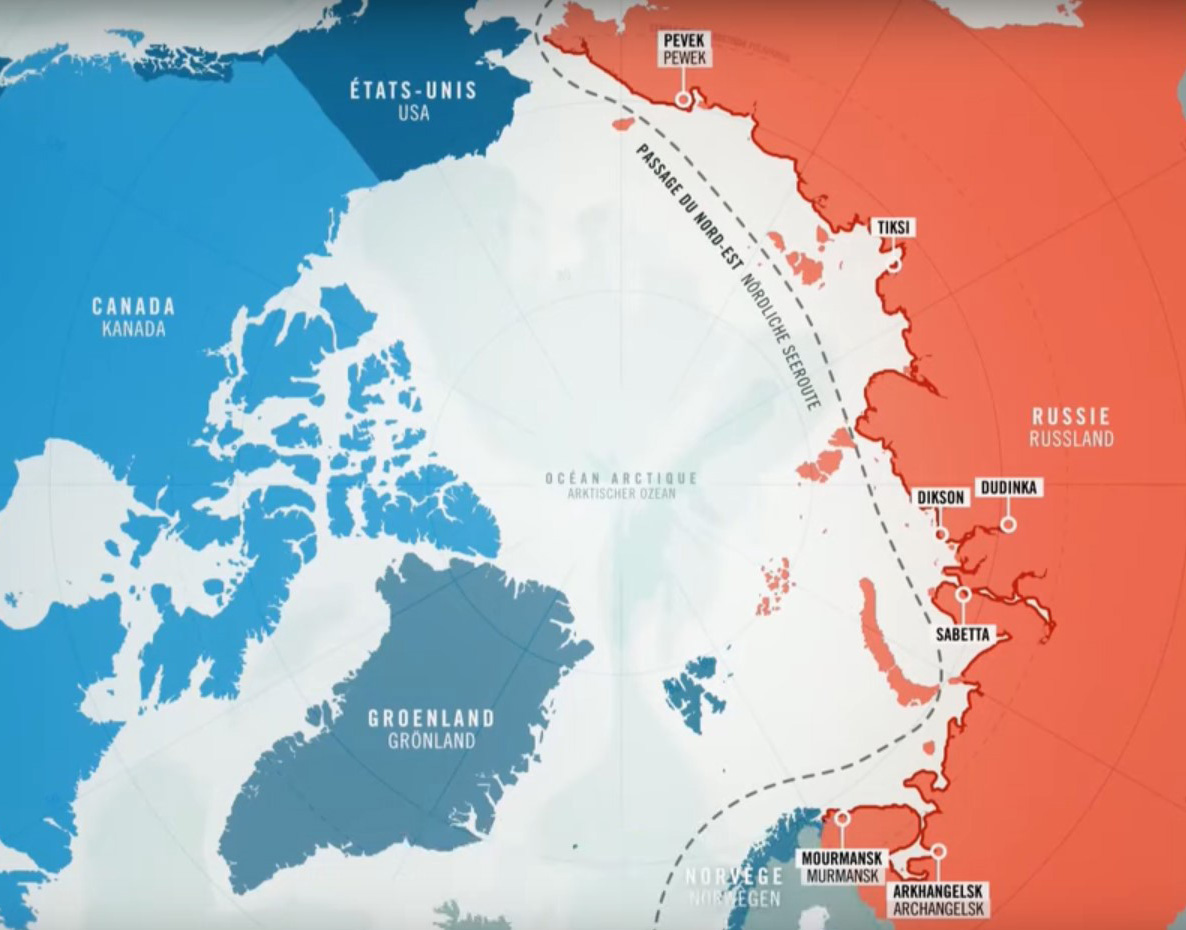
Russian arctic coastline to have 16 large ship ports
Russia’s state-owned unified natural gas transportation system’ includes a vast network of pipelines and compressor stations extending more than 150,000 km across Russia. This network plus the 50.000 km oil pipeline network are probably the most valued Russian state assets outside the oil and gas itself.
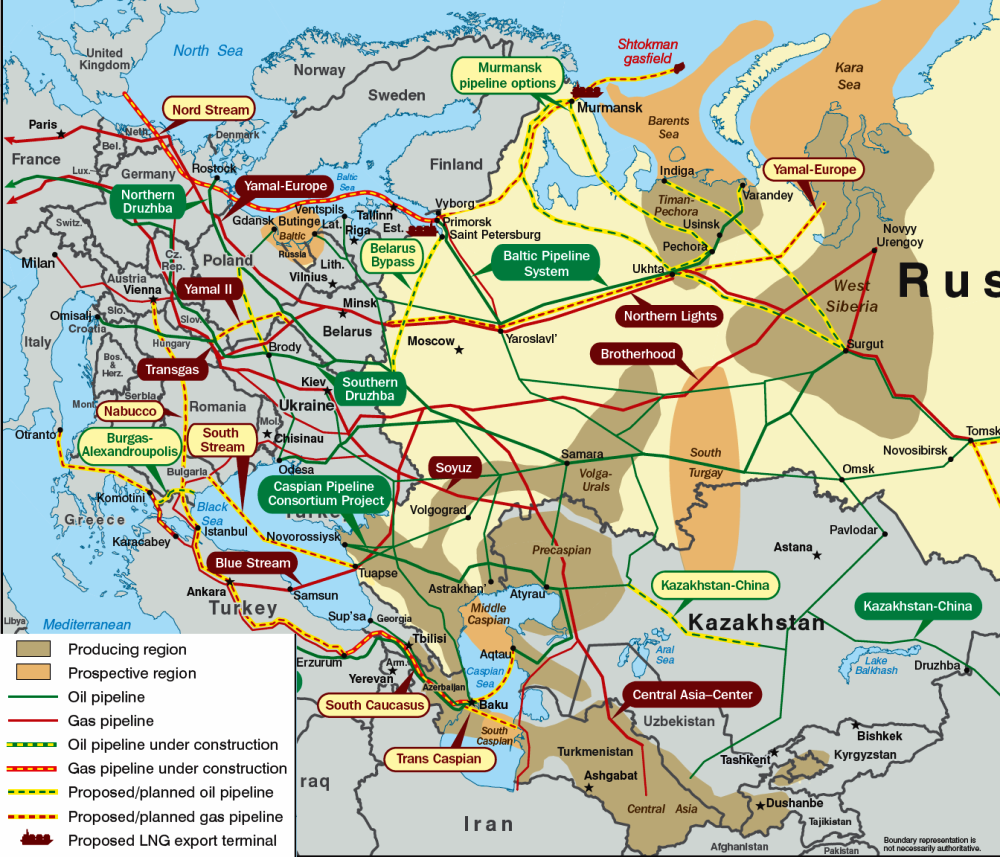
Russian oil products can be exported to foreign markets in 3 routes:
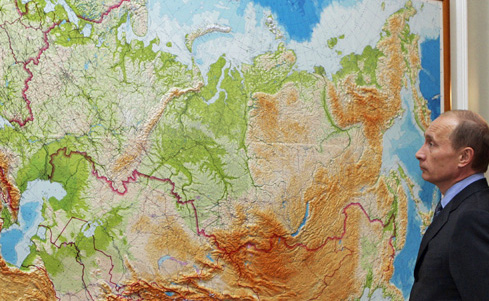
Nord Stream 1, 2 , 3, etc.
The 1st Baltic Pipeline System (BPS) was completed in 2006 to bring Russian oil to western markets in Europe and beyond, bypassing the land and ports of now NATO Baltic and other countries.
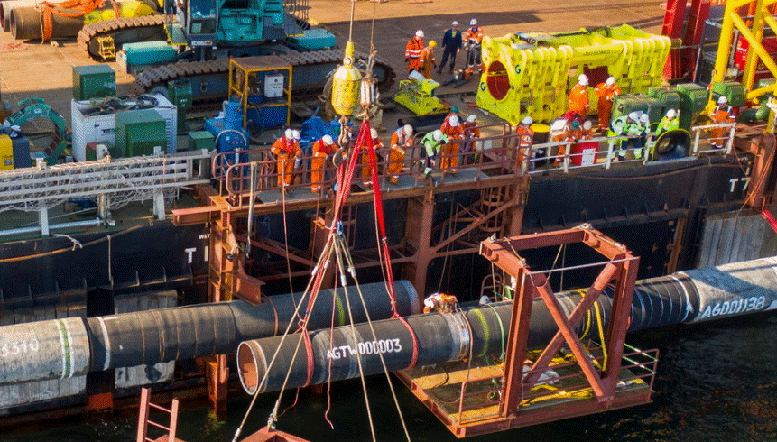
Nordstream-2 pipelines finished 9-9-2021
Now a 2nd twinset of Baltic sea pipelines connects Russia directly with Germany and W-Europe. A gas deposit in the Russian sector of the Barents Sea, will also be a part of the gas supply to Germany.
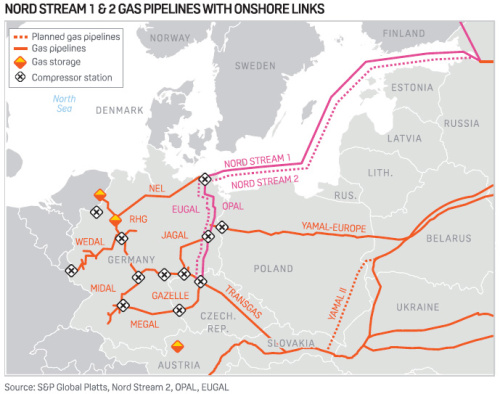
Blue Stream and Turk Stream 1, 2, etc.
In 2005 Russia’s 1213 km underwater ‘Blue Stream’ gas pipeline across the Black Sea bottom to Turkey was finished. The SouthStream pipeline plan to Bulgaria was replaced by 2 Turkstream Black Sea pipelines, finished in 2019; one will be extended into Greece, and via Bulgaria, Serbia, Hungary, to Austria.
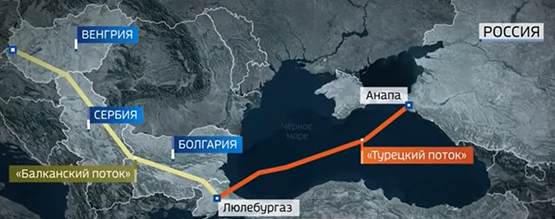
The Sth-Caucasus oil pipeline, is running for a few km through Russian Army controlled South-Ossetia’s territory, to ensure control over the flow of oil in case the W-DC’s spreading of "color revolutions in the name of democrazy” through Europe and the Greater Middle East goes too far.
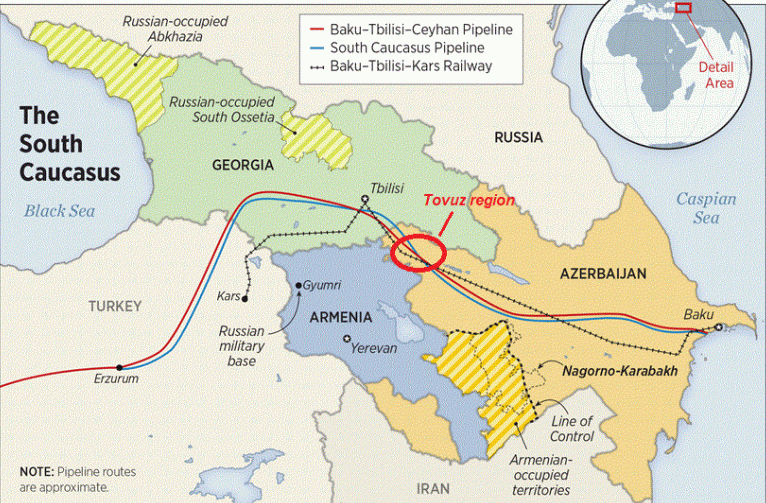
The BP operated SCP, Trans-Anatolian Natural Gas Pipeline (TANAP), and Trans Adriatic Pipeline (TAP) supply 25B m³/yr natural gas from the Caspian sea to Southern and Eastern Europe. The Baku-Tbilisi-Ceyhan (BTC) pipeline is the 1st direct oil link between the Caspian Sea and the Mediterranean, capable of exporting 1 Mio barrels oil/day. Owned 30% by BP, 30% by Azerbaijan + Turkey’s state oil companies and 40% by EU companies.

Power of Siberia 1, 2, etc.
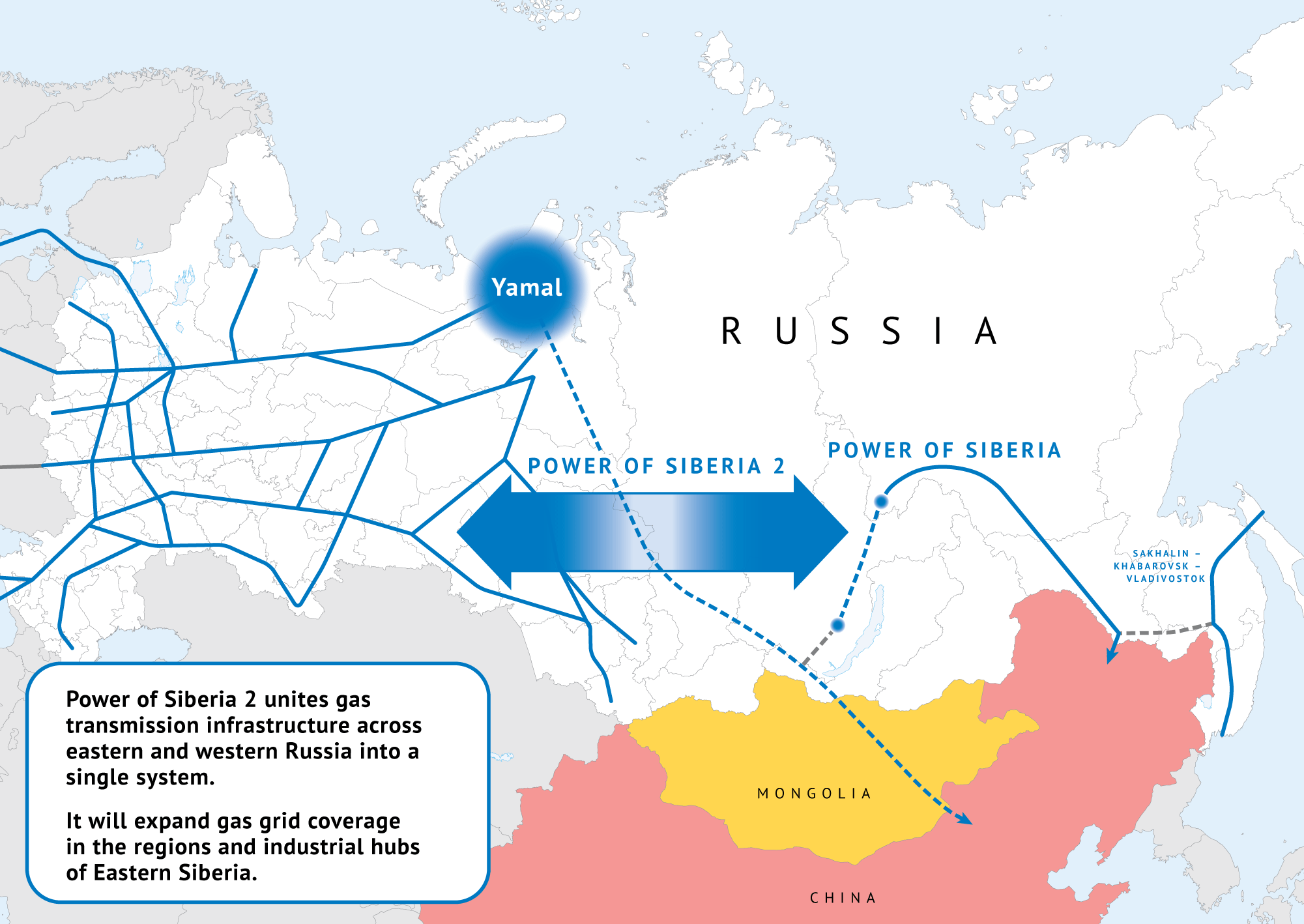
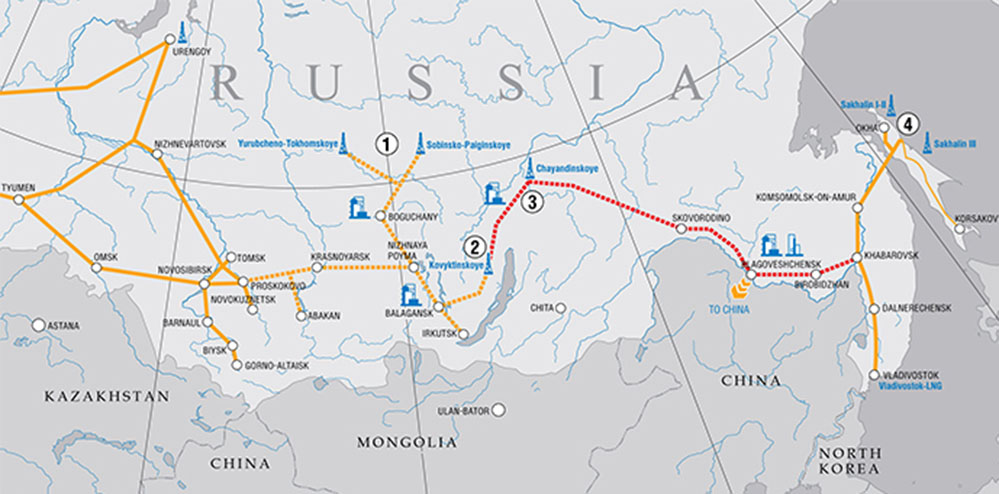
The East Siberia-Pacific Ocean Pipeline (ESPO), a vast oil pipeline from Lake Baikal area in East Siberia, to Russia’s Pacific Ocean coast, has been finished. Then an oil refinery on the Amur River near Russia’s China border allows for the sale of refined oil/gas products to China and Asian markets:
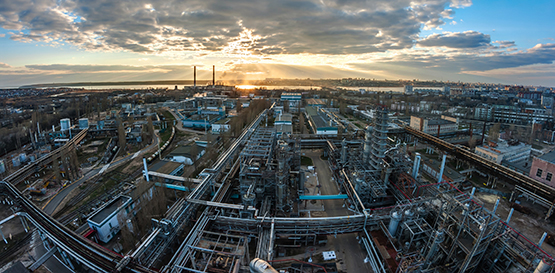
The ESPO will eventually supply oil to Japan, China, and North & South Korea through adding branch lines. The enormous route provides a clear roadmap for energy cooperation between Russia, China, Japan and other Asia-Pacific countries.
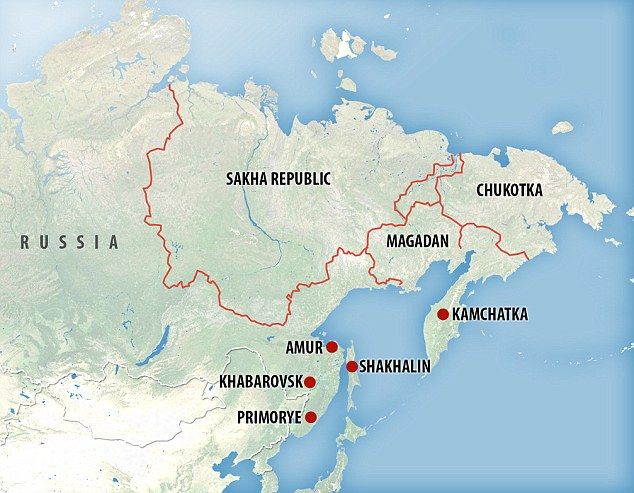
Sakhalin 1, 2, etc., Kamchatka Peninsula
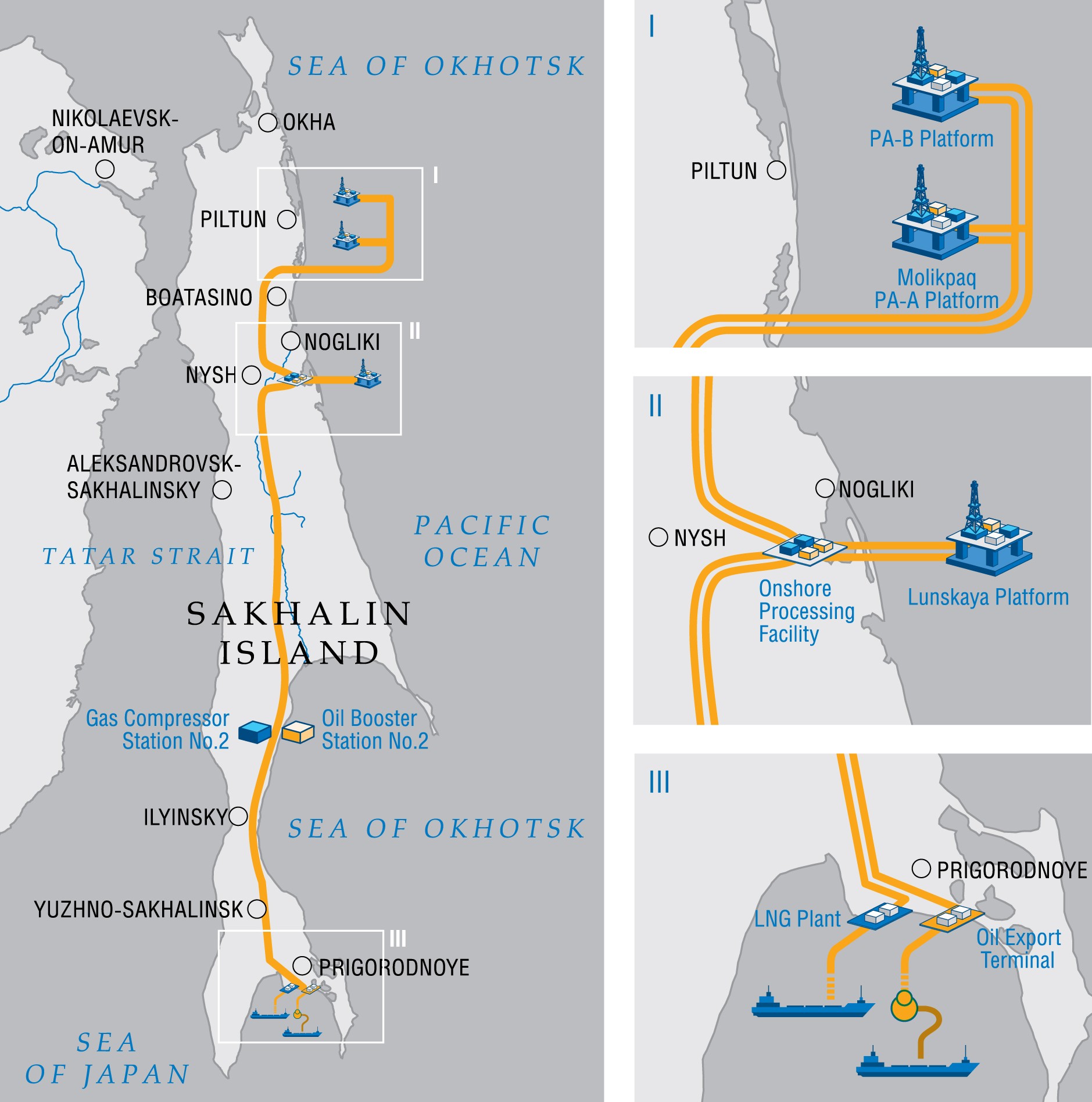
Russia reins in Big Oil & Gas
In 2006 two 'minor' disputes resulted in the revocation of the environmental permit for Japan's & Shell’s Sakhalin II Liquified Natural Gas project, for delivering LNG to Japan, South Korea, etc, and for Exxon/Mobil's oil terminal on Sakhalin Island, a vast island just north of Hokkaido, Japan, containing immense oil and natural gas reserves.
The $20B Sakhalin II LNG project is employing over 17,000 people. It’s the world’s largest integrated oil and gas project, and includes Russia’s first offshore oil production, as well as Russia’s first offshore integrated gas platform, and an onshore LNG terminal on Kamchatka Peninsula.
In 1992 the broke Russian government granted the oil majors generous exploration rights to two large oil projects, Sakhalin I and Sakhalin II. Under a so-called PSA or Production Sharing Agreement, they got tax-free concessions.
Russia’s government would get paid in oil and gas only after all project production costs had first been covered. After the oil majors announced yet another cost increase (30%) in the project, thus avoiding to pay Russia anything, the Russian government told the oil majors about the environmental problems.
The revocations were an attempt by the Russian government to regain control over their own oil and gas resources. It would cohere with President Putin’s emerging energy strategy.
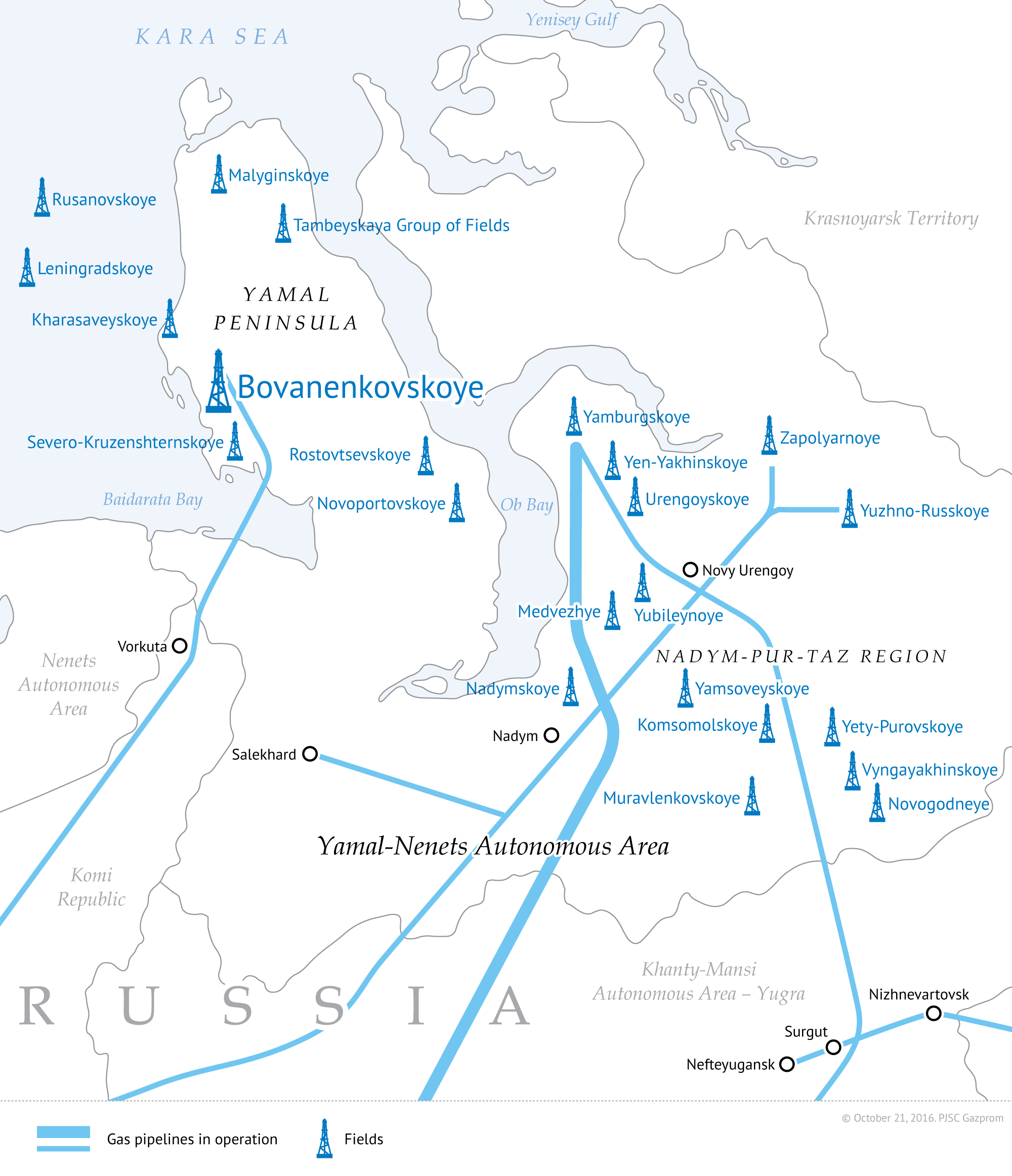
Yamal Peninsula
A new gas production center is actively evolving in the Yamal Peninsula. The center will eventually become a major contributor to the Russian gas industry development. Yamal will produce up to 360 billion cubic meters of gas per year.
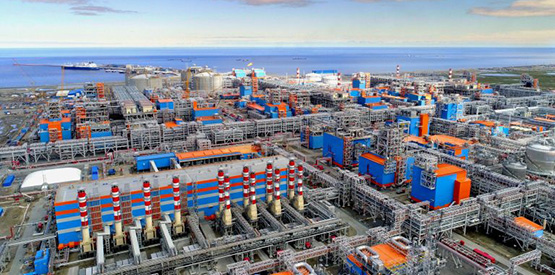
Number of fields: 32. Total reserves and resources of all fields in the Yamal Peninsula: 26.5 trillion cubic meters of gas, 1.6 billion tons of gas condensate, and 300 million tons of oil. Production in Yamal: 2017: 82.8 billion cubic meters of gas.
The Shtokman field has about 4 Trillion cubic mtr of gas, shipped to Murmansk's LNG terminal, with many Trillions more in the Arctic Ocean.
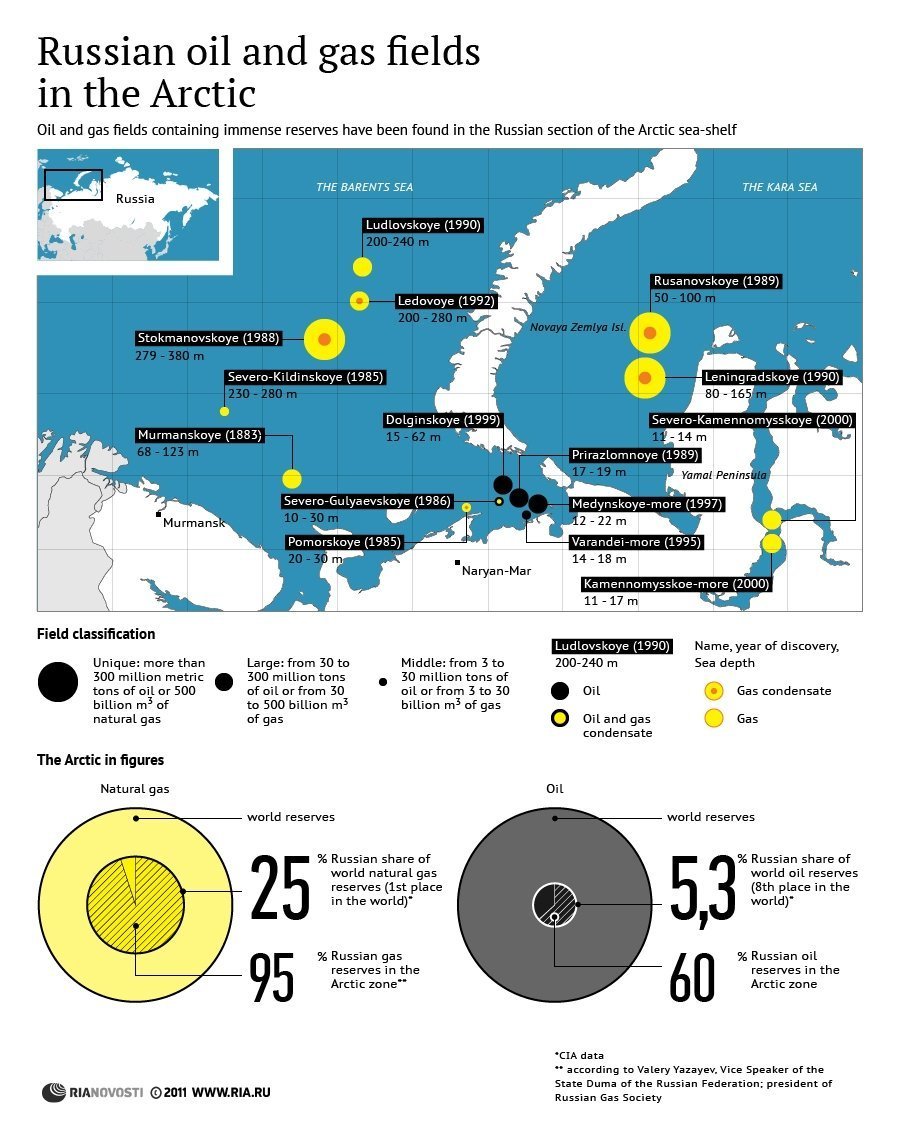
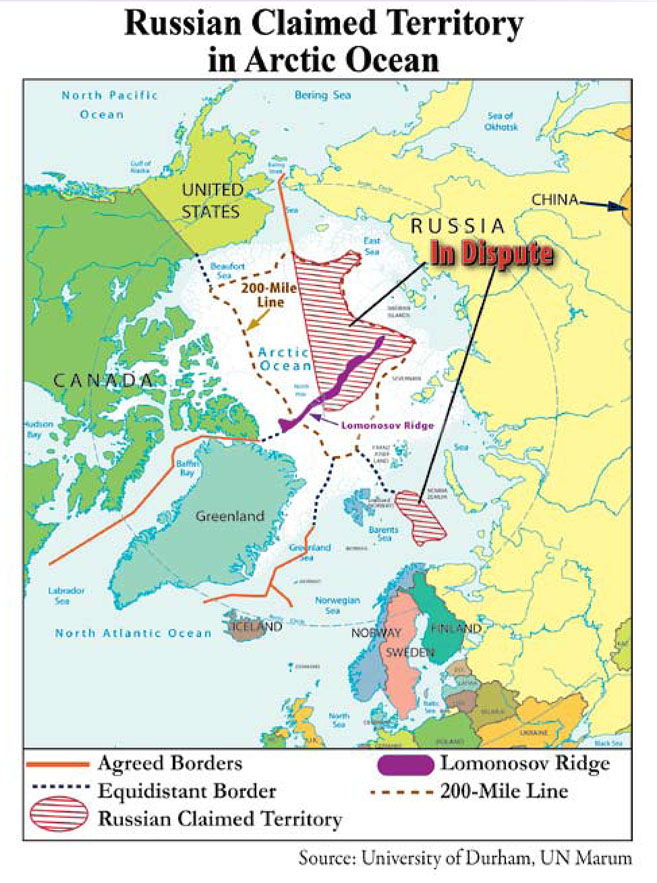
How (un)profitable are some of the above-mentioned mega-projects? Watch video below:
Russia becoming the leader in hydrogen tech
Russia's vast natural gas reserves and renewables potential could make it one of the world's largest hydrogen producers within the next decades.
Its mineral and energy wealth has provided the necessary income to rebuild the country after 1990, and exert influence abroad. Now, Russia is slowly repurposing its energy industry by early investments in hydrogen technologies, and cooperation with foreign partners in Japan and Germany.
Hydrogen may constitute 7-25 % of the global energy balance by 2050, if higher production costs and the challenges related to transportation are resolved.
For this, Russia intends to use its current assets such as the world's largest natural gas reserves, strong nuclear know-how, and high-class energy research facilities.
Russia has one of the world’s largest nuclear plant fleets, plus a significant order portfolio for new nuclear plants worldwide is an incentive to develop and improve existing technologies. Therefore, nuclear energy is seen as an asset which, through the process of electrolysis, could be used to produce ‘yellow’ hydrogen, via anion exchange membrane (AEM) electrolysers.
The Japanese intend to expand their knowledge by building on the experience of importing hydrogen from their enterprise in Australia, starting in 2021.
Novatek is planning to build steam-methane reforming facilities on the Yamal peninsula to produce hydrogen. Additional carbon capture and carbon storage projects will be required to produce the so-called 'blue' hydrogen, a low CO2 hydrogen.
Russia’s Gazprom already operates extensive pipeline infrastructure to Europe and is expanding capacity to China. Due to the lifetime of the pipelines, hydrogen could be used to extend operations well after natural gas has been phased out.
The new technology they are looking into, is a process called methane pyrolysis. For this, natural gas is still used as the starting point of the process, but the by-product is different from methane reforming. By using heat, natural gas molecules are broken down into hydrogen and carbon which is not gaseous but solid. The carbon then can be used for other industrial processes and increase the value of the process.
There is also a bright future for wind in the country. Especially the coastal regions in the northwest are highly suitable for ‘green’ hydrogen (solar & wind) production through electrolysis. The existing natural gas pipelines could be reused to pump hydrogen to consumers.

US plans for ‘Nuclear Primacy’
In a revealing article titled ‘The Rise of US Nuclear Primacy,’ in 2006, the following claim was made:
“For the first time in almost 50 years, the USA stands on the verge of attaining nuclear primacy. It will soon be possible for the USA to destroy the long-range nuclear arsenals of Russia or China with a first strike. This dramatic shift in the nuclear balance of power stems from a series of improvements in the United States' nuclear systems, the precipitous decline of Russia's arsenal since 1991, and the glacial pace of modernization of China's nuclear forces. Unless Washington's policies change or Moscow and Beijing take steps to increase the size and readiness of their forces, Russia and China and the rest of the world will live in the shadow of U.S. nuclear primacy for many years to come.”
The writers also concluded that the USDS is and has been, since the 1950's, intentionally pursuing global nuclear primacy. The 2002 National Security Strategy explicitly stated that it was official US policy to establish global military primacy. An unsettling thought for all other nations today given the dozens of invasions and other aggressive actions of the USDS since WWII. This included the controlled demolition of the WT-towers on 9/11/2001 for the purpose of avoiding lengthy studies, deliberations and probable defeat, but forcing a quick ratification, of the comprehensive and extremely intrusive Patriot Act by the Senate and Congress just a few weeks later.
The multi-billion dollar construction of a US missile defense, sold to the world as a defense against terror attacks, has been recognized as really aimed at the other real nuclear powers, Russia & China.
However, the type of missile defenses planned are add-ons to a USDS first-strike capability, not as a stand-alone shield. If the USDS launched a nuclear attack against Russia or China, a simple missile-defense system would be enough to protect it against any retaliatory strikes, because the devastated enemy would have few warheads left to strike back.
The USDS is also building, via NATO, a European Missile Defense System. Completion of this system, the militarization of the entire Middle East, the encirclement of Russia and of China from a connected web of about 800 US military bases in 150 countries, employing about 200.000 active-duty military personnel, plus at least 50.000 under-cover agents, put up in the name of the War on Terror, all now appear to the Kremlin as part of a deliberate USDS strategy of Full Spectrum Dominance:
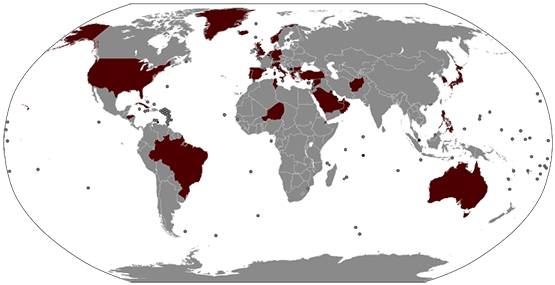
The Pentagon refers to it also as ‘Escalation Dominance,’ the ability to win a war at any level of violence, including a nuclear war. W-DC unilaterally declared an end to the Anti-Ballistic Missile Treaty, the Start II Treaty, and almost all other treaties.
Since 1945, the USDS continues to "occupy" the economically most successful regions in the world: Germany with initially 400.000, now "reduced" to 35.000, Japan with 55.000, S-Korea with 30.000, the Persian Gulf with 50.000 active-duty military personnel, plus the blackmail material they have on every European political leader, to ensure they obey all of USDS's commands.
Europe’s tolerance for abuse by its American ‘partner’ has invoked a Stockholm Syndrome problem, a “coping mechanism” to deal with a major trauma, like WWII. It is an irrational sympathy with a party that actually inflicts hardship and injury, as seen with hostage holding of 10,000's of innocent refugees as human shield for sheltered terrorists in Syria, torturing in other countries many prisoners of war, survivors of concentration camps, slaves and prostitutes. alll victims have to gradually be introduced to the objective truth of their situation. Europe needs to wake up from delusions about its American ‘ally’, fully controlled by their military-medical-chemical Industrial Complex, as well the stock-bond-derivatives-commodity-currency exchanges controlled by the USA's largest multi-nationals, banks, and banking families.
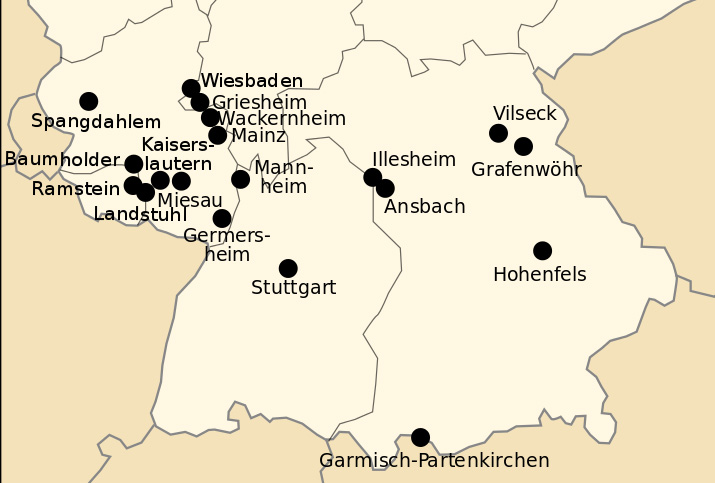
USDS bases in Germany
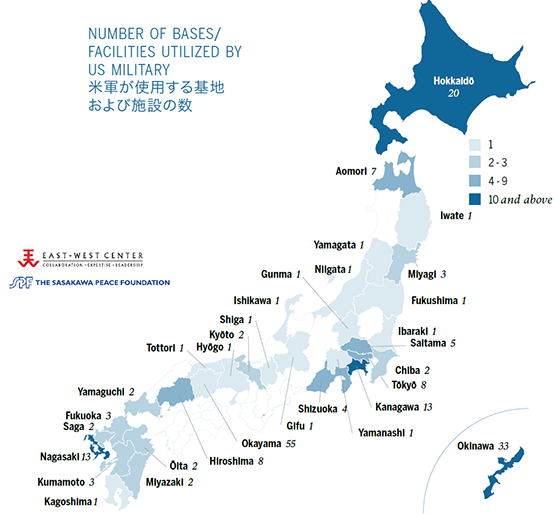
USDS bases in Japan
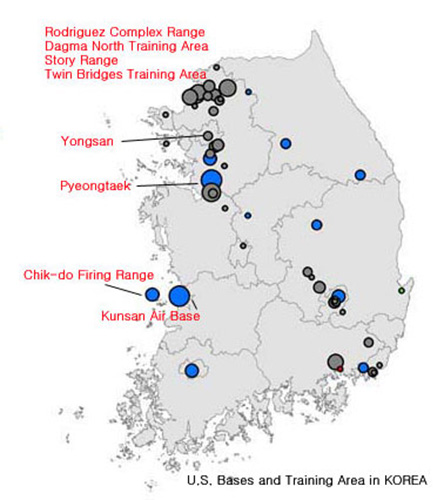
USDS bases in Sth-Korea
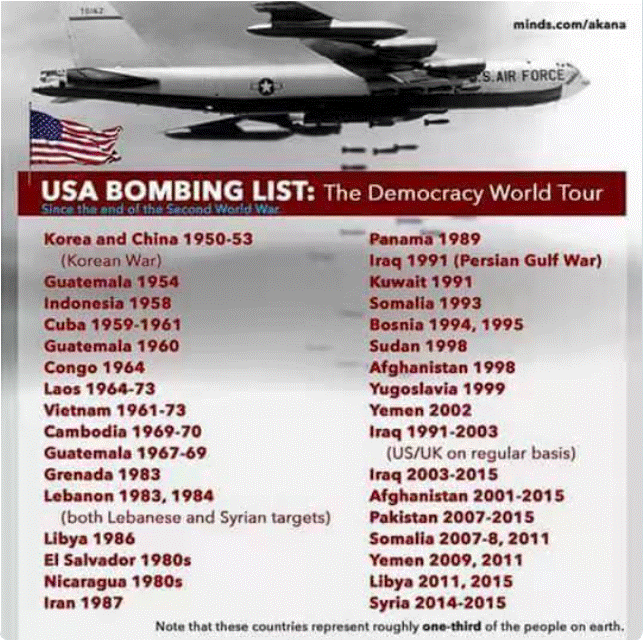
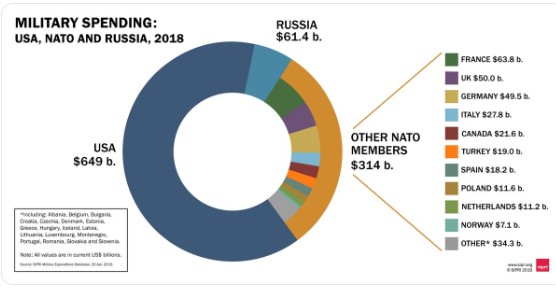
Moscow’s military, economic, and technological status
Russia has been consistently fielding top-notch hypersonic military technology at various international trade shows, and has been effective in the demonstration of its wide-spread defense capabilities.
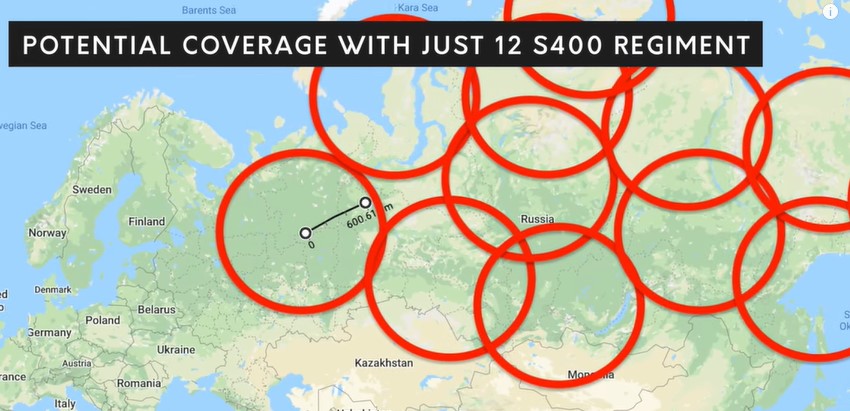
Russia's S-400 and S-500 defense systems, and many other high-tech land- & air-craft, battle-tested in Syria, and compared against American equipment in India, are more potent than American-made systems, leaving the Russian complex with an undisputed claim of superiority over the American systems, possibly including space:
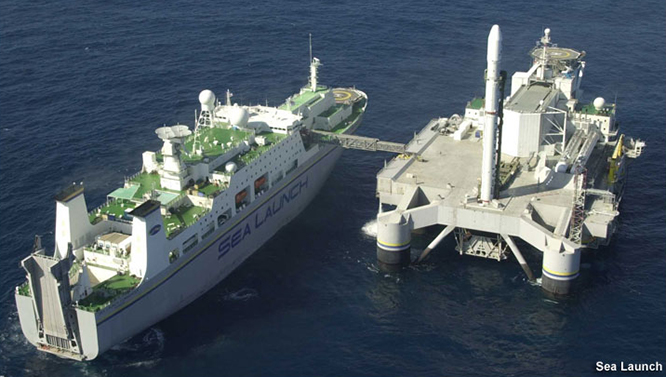
Defense weapons, safe & closed-loop nuclear reactors, and agricultural exports, in addition to oil and gas, have been one of the best ways for Russia to earn plenty of hard currency. This has implications for America's future combat operations since practically all terrorist armed formations across the globe are fielded with the best Russian weapons or its derivatives.
Russia is already the world's largest grain exporter (45 MM ton out of a total production of 120 MM ton in 2019/20), and soon will be the world's largest non-GMO food exporter, using the millions of hectares of former USSR commune, arable, now very fertile land.
A floating Ruble as currency, and the focus on a progressive, digital, economic policy of making the bureaucracy much smaller, simpler, and more transparent through implementation of AI and other technological innovations, whereby each individual can reach its full potential, through a constant drive for self-development, that should result in a more comfortable lifestyle and living environment.
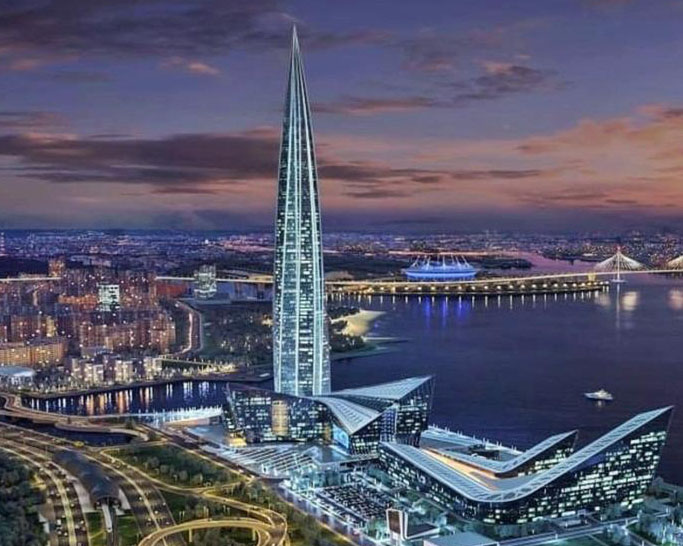
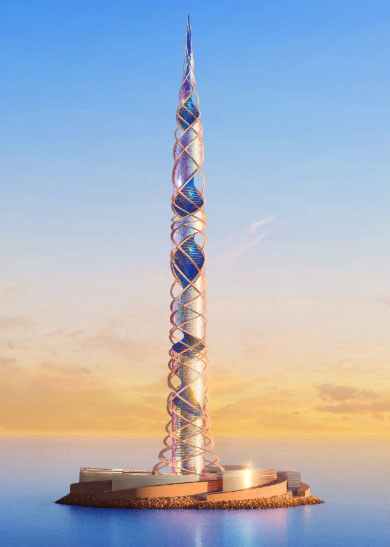
Gazprom's Lahta 1 & 2 Towers in St. Petersburg
The strategic nuclear forces have been a priority for Russia, because they balance the current world order. Their finances are on a solid footing. The Russian Central Bank has become one of the 4 largest foreign exchange & gold holders with reserves of over $600 billion.
The contest for global power will increasingly pivot to the extraction and refinement of minerals and component materials that are critical to sustaining the high-tech economy model, away from carbon energy resources. These products are found in abundance in Russia and China.
Also Russia's and China's modern manufacturing “ecosystem” makes it much easier to redeploy and pivot to new priorities when there are shortages in vital areas. Their ecosystems have to be large enough to encompass all of the niches that make it work.
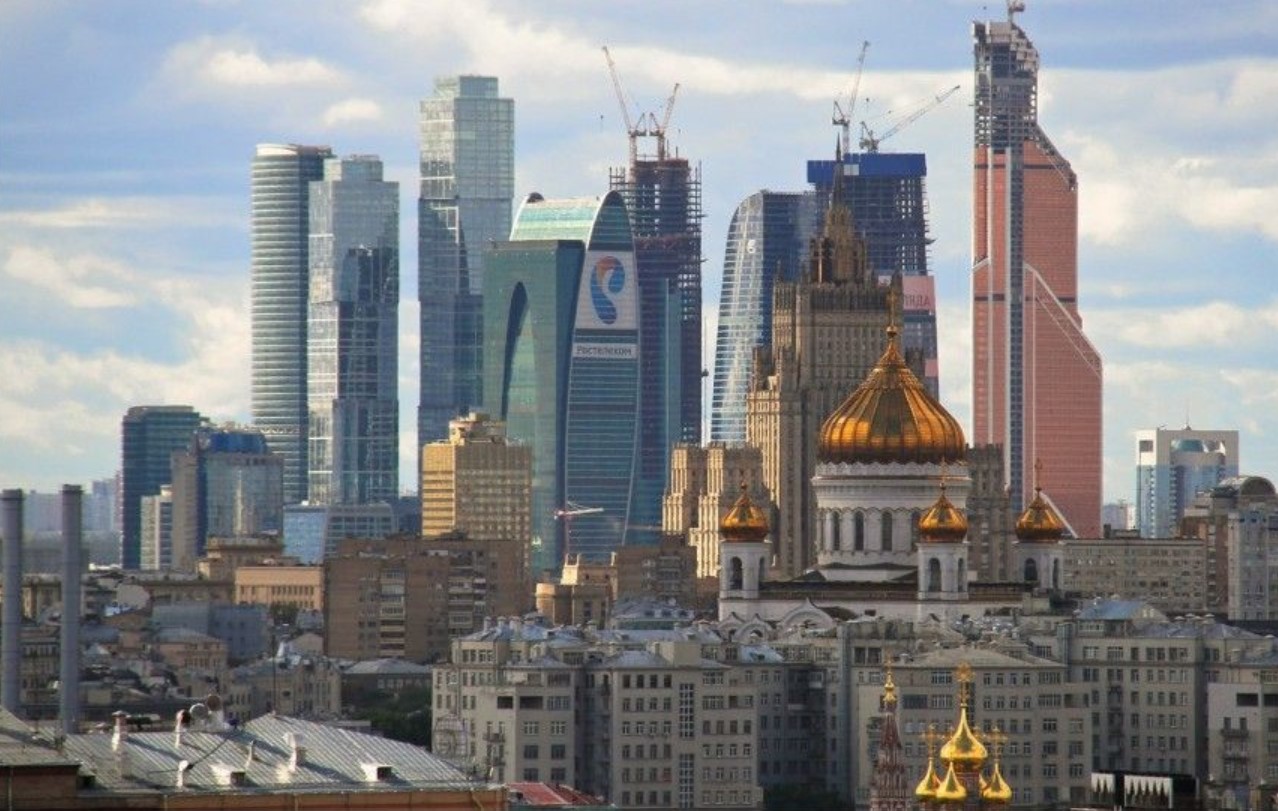
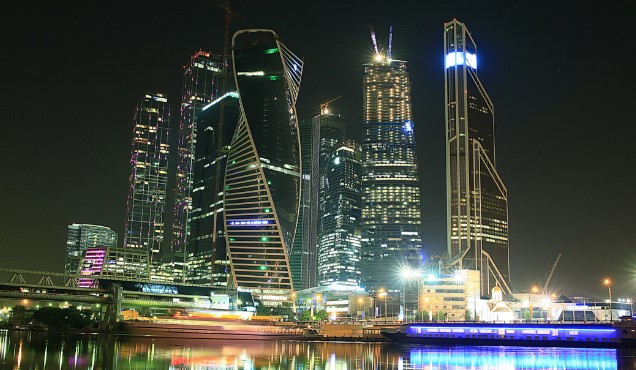
The push for a US ‘nuclear primacy’ over Russia and China is the main factor in USDS's unruly world politics today, which could lead to a WW III, a biological/chemical, or nuclear conflagration by miscalculation.
US history shows that the American Natives could attest to the fact that US President, Andrew Jackson, took savagery to new levels, with the passage of the Indian Removal Act under his presidency in 1830. The act led directly to the Trail of Tears, when up to 100,000 men, women, and children were ejected from their land and forced to march west to make way for white settlers. Up to 15,000 died as a result.
US President, Theodor Roosevelt, earned fame for his imperialistic role in the Spanish-American War in Cuba 1898. The psychopathic proclivities of one of USA’s most celebrated presidents are enshrined in his own words: “If I must choose between a policy of blood & iron and one of milk & water, I am for the policy of blood & iron. It is better not only for the nation but in the long run for the world.”
Venerated US General D. MacArthur, who commanded US forces in the 1950’s Korean War, boasted in 1964 that he “would have dropped 30 to 50 tactical atomic bombs on N-Korea’s air bases and other depots strung from the NW tip to the NE tip of N-Korea near the border of the USSR.” President Truman, sacked him after realizing that the asylum is not the only place where lunatics exist.
US Air Force topman, Curtis Le May, urged Kennedy to nuke Cuba regardless of the risks of a Soviet response and the onset of WWIII.
Capitalism controlled by bankers and speculators gives free rein to companies to make profits on how they see fit. That has prioritized short-term quarterly earnings, massive dividend payouts and unprecedented spending on stock repurchases over productive investment in innovation.
As GM’s 2019 bail-out experience illustrates, the resultant profits did not go to spur domestic reinvestment, which in turn creates domestic employment, but abroad to expand China’s manufacturing base. GM is but one example of the hundreds of major corporate actors that have denuded the country’s industrial ecosystem, creating gaps in the U.S. workforce and shortages of vital skilled labor.
There are also multiple examples of US companies acquiring smaller innovative companies solely to discontinue the target’s innovation projects and preempt future competition, instead of strengthening and expanding the small company's product base.
US President Trump was elected on a platform of ending America’s propensity for regime change wars, conducted under previous Dem/Rep administrations, and drawing down the expansive US military footprint across the globe. His thinking was based on the empirical evidence that these wars had only succeeded in making bad situations worse, fomenting instability rather than stability, while at the same time catalyzing the scourge of international terrorism. His attempts to unpick W-DC’s doctrine of full spectrum dominance, has earned him the wrath of the War Party, the neocon & liberal interventionist W-DC shadow elite establishment (the eternal enemies of the American people), and the Pentagon, including its vast intelligence community. This President came to office viewing the world through the lens of economic opportunity, regardless of where and with whom those opportunities may lie, and is finally trusting his instincts more than his war-hungry advisers.
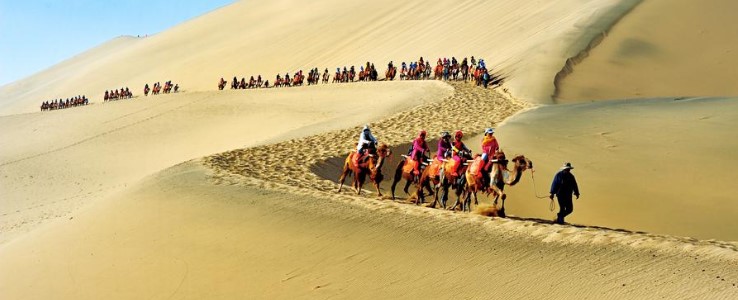
The US dogs still bark while the "New Silk Road" caravan advances
Massive invasions by Western Nations:
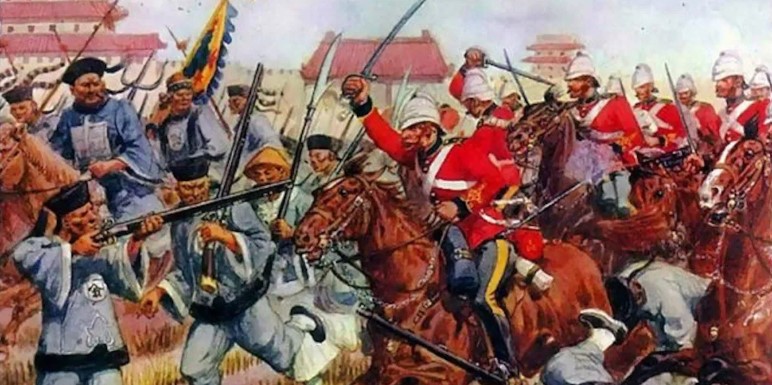
Beijing being invaded in 1860 and in 1900 by the barbaric British
and in 1931 China was invaded by barbaric Japan, lasting until 1945.
Russia being invaded by the barbaric German Nazi's
Then the World-Island nightmare of Mr. Mackinder a.o. would be fulfilled, ironically, mostly due to the unilateral, arrogant, and aggressive, financial, and foreign policy of an over-confident supremacist bully, the USDS, that does not want to be reminded of its still continuing 200 years of wars of partial occupation despite promises otherwise, domestic meddling, extensive looting, poisoning, containment actions, and deep humiliation of the billion+ people in China and Russia, by the leadership of the 'civilized' Western World that is irrevocably losing its leadership of the modern world.
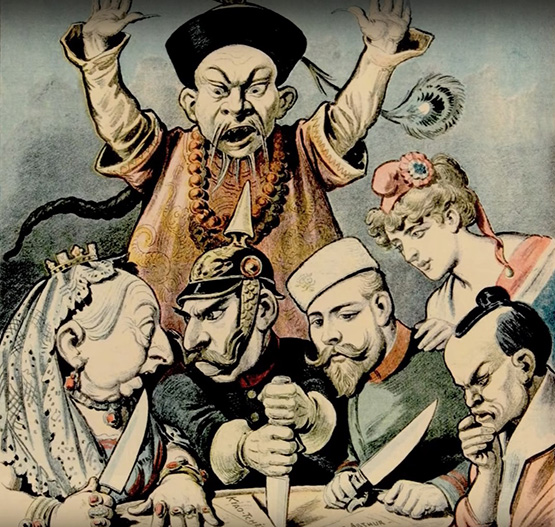
How would you feel as a citizen of any of these eur-asian countries?
What would you do if you had a chance?
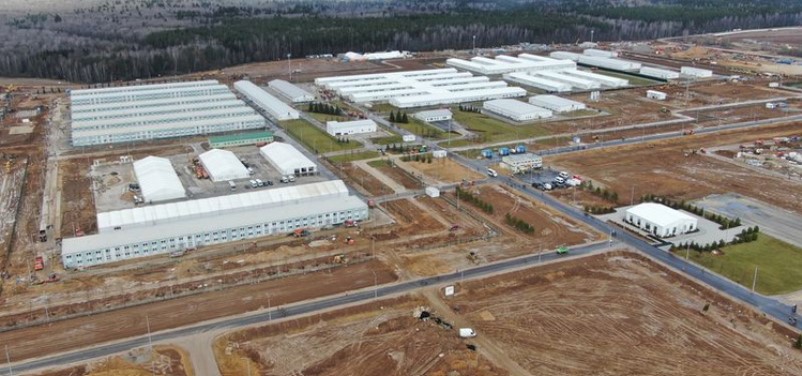
Moscow’s 80.000 sqm Infectious Diseases Hospital complex with
800-IC-beds and a 1,300-capacity hostel to accommodate 1.000+ staff,
built by 11.000 construction workers on 42 ha. in 4 weeks, in spring of 2020.
16 more new ID Hospitals were also built on military bases all over the country.
For what?
On August 11, 2020, both Chinese and Russian scientists were granted patent approval for their ready-to-use vaccine against C-19. The Russians call theirs, Sputnik. The Sputnik V vaccine essentially consists of two components. The first is a harmless adenovirus vector rAd5, a "rocket carrier" that delivers the second component, a piece of the COVID-19 genome or, so to speak, an "orbital station" into a human body, which gave the vaccine its unusual name.
This viral vectors method was developed by the Gamaleya National Research Center in Moscow a long time ago and has since been tested in several vaccines, namely against Ebola and another type of coronavirus, called MERS. They extracted a fragment of genetic material from novel coronavirus SARS-COV-2, which codes information about the structure of the spike S-protein, which forms the virus “crown” and is responsible for connection with human cells. They inserted this fragment into a familiar adenovirus vector for delivery into a human cell.
To make the [immunity] more permanent, the same "orbital station" is delivered into the body three weeks later, using another "carrier", vector rAd26. As a result, the body doesn't produce strong immunity to either the vector rAd5 or rAd26 adenoviruses, but forms a strong defense against the coronavirus.
Since the vector for the vaccine is a common cold virus, people may have preexisting immunity that kills the viral carrier before the vaccine can take effect, which could partially hamper the immune responses.
In China a similar method was developed by the Academy of Military Medical Sciences and Biotech company CanSino Biologics, using only the replication-defective adenovirus type rAd5 as the vector to express SARS-CoV-2 spike protein.
As it is as simple as all ingenious things in the world, so far no one else has managed to achieve it:
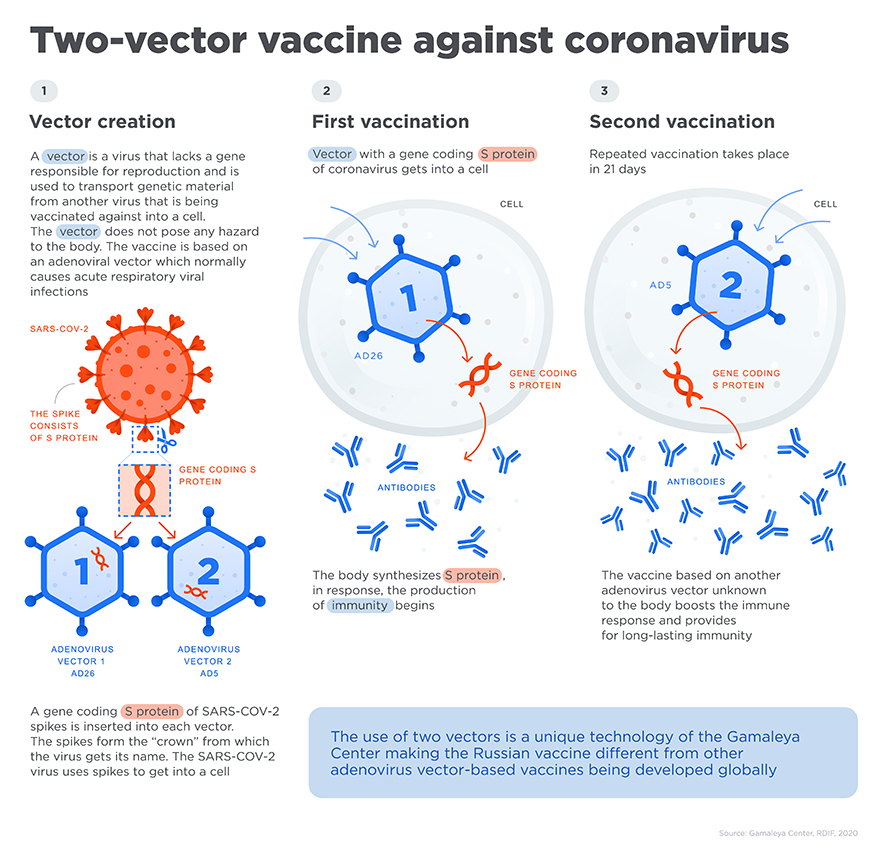
The President of Belarus, Lukashenko, publicly dismissed other countries’ C-19 measures as “psychosis”,
and declared “it’s better to die standing than to live on your knees in this crazy, disoriented world",
while he is celebrating the 75th anniversary Victory of WWII, together with
more than 10.000 spectators seated close together without face masks,
and many servicemen & women marching close together in groups.
Are the world's ever-largest (C-19) lockdowns staged events of
a man-made virus patented in 11/2018 by the UK Pirbright Institute and/or
a real biological attack from US military bases surrounding the Russian Federation?
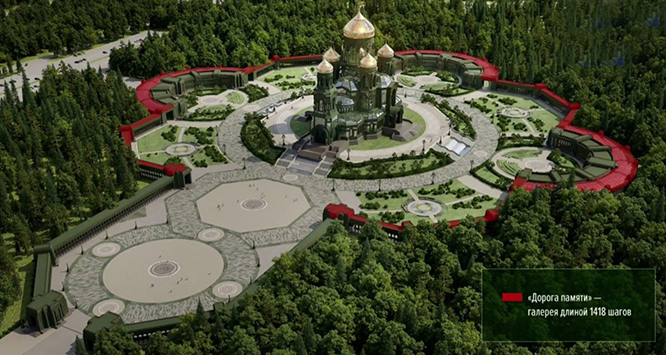
New Russian Cathedral for the Military,
95-meter high and 10,950 sq. m.
can house up to 6,000 people at a time.
Funded by donations from the Russian people, including a Road of Memory,
marked in red, with tens of millions of photographs of WWII veterans built into it.
The main steps to the church are forged from melted-down German war material.
Its interior features all the milestone victories of the long and hard-fought Russian history.
Changes to the Russian Constitution became law on July 4th, 2020,
after nearly 2/3 of eligible voters showed up to vote for it.
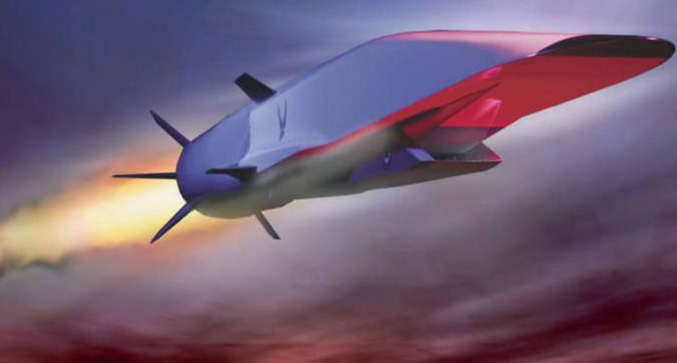
To defend itself against daily US-NATO agression, Russia developed the Zircon missile which can travel at a speed of Mach 9 (11,025 km/h). It will penetrate western naval defense systems. As the missile flies at hypersonic speeds within the atmosphere, the air pressure in front of it forms a plasma cloud as it moves, absorbing radio waves and making it practically invisible to active radar systems. Zircon exchanges information in flight and can be controlled by commands if necessary.
The Bank of Russia’s move to link the ruble to gold and link commodity payments to the ruble is a paradigm shift. As the dominos fall, these events could reverberate in different ways. Increased demand for physical gold. Blowups in the paper gold markets. A revalued gold price. A shift away from the US dollar. Increased bilateral trade in commodities among non-Western counties in currencies other than the US dollar or Euro.
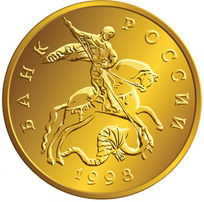
The new convergent economic system that emerged in the PRC (People’s Republic of China) and India is the next inevitable stage of development, combining the benefits of both centralized strategic planning and market economy, and of both state control of the monetary and physical infrastructure and entrepreneurship. The new economic system united various strata of their societies around the goal of increasing common wellbeing in a way that is substantially stronger than the Anglo-Saxon and European alternatives. This is the main reason why Washington will not be able to win the global hybrid war that it started. This is also the main reason why the current dollar-centric global financial system will be superseded by a new one, based on a consensus of the countries who join the new world economic order.
In the first phase of the transition, these countries fall back on using their national currencies and clearing mechanisms, backed by bilateral currency swaps. At this point, price formation is still mostly driven by prices at various exchanges, denominated in dollars. This phase is almost over: after Russia’s reserves in dollars, euro, pound, and yen were “frozen,” it is unlikely that any sovereign country will continue accumulating reserves in these currencies. Their immediate replacement is national currencies and gold.
The second stage of this transition will involve new pricing mechanisms that do not reference the dollar. Price formation in national currencies involves substantial overheads, however, it will still be more attractive than pricing in ‘un-anchored’ and treacherous currencies like dollars, pounds, euro, and yen. The only remaining global currency candidate – the yuan – won’t be taking their place due to its inconvertibility and the restricted external access to the Chinese capital markets. The use of gold as the price reference is constrained by the inconvenience of its use for payments.
The third and final stage on the new economic order transition will involve a creation of a new digital payment currency founded through an international agreement based on principles of transparency, fairness, goodwill, and efficiency. I expect that the model of such a monetary unit that we developed will play its role at this stage. A currency like this can be issued by a pool of currency reserves of BRICS countries, which all interested countries will be able to join. The weight of each currency in the basket could be proportional to the GDP of each country (based on purchasing power parity, for example), its share in international trade, as well as the population and territory size of participating countries.
In addition, the basket could contain an index of prices of main exchange-traded commodities: gold and other precious metals, key industrial metals, hydrocarbons, grains, sugar, as well as water and other natural resources. To provide backing and to make the currency more resilient, relevant international resource reserves can be created in due course. This new currency would be used exclusively for cross-border payments and issued to the participating countries based on a pre-defined formula. Participating countries would instead use their national currencies for credit creation, in order to finance national investments and industry, as well as for sovereign wealth reserves. Capital account cross-border flows would remain governed by national currency regulations.
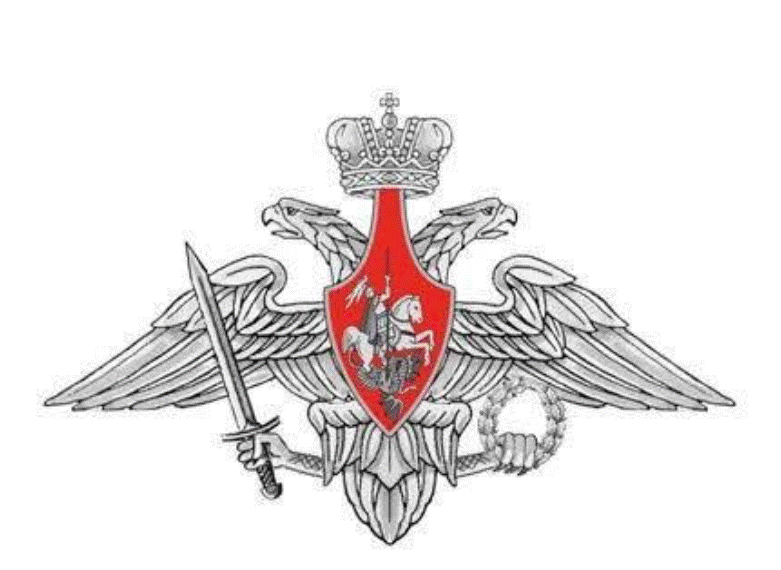
The Twin-headed Russian eagle looking simultaneously West and East